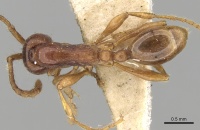Aenictus punensis
| Aenictus punensis | |
|---|---|

| |
| Scientific classification | |
| Kingdom: | Animalia |
| Phylum: | Arthropoda |
| Class: | Insecta |
| Order: | Hymenoptera |
| Family: | Formicidae |
| Subfamily: | Dorylinae |
| Genus: | Aenictus |
| Species: | A. punensis |
| Binomial name | |
| Aenictus punensis Forel, 1901 | |
Nothing is known about the biology of Aenictus punensis.
Identification
A member of the pachycerus group.
Keys including this Species
Distribution
Distribution based on Regional Taxon Lists
Oriental Region: India (type locality).
Palaearctic Region: China.
Distribution based on AntMaps
Distribution based on AntWeb specimens
Check data from AntWeb
Countries Occupied
| Number of countries occupied by this species based on AntWiki Regional Taxon Lists. In general, fewer countries occupied indicates a narrower range, while more countries indicates a more widespread species. |

|
Estimated Abundance
| Relative abundance based on number of AntMaps records per species (this species within the purple bar). Fewer records (to the left) indicates a less abundant/encountered species while more records (to the right) indicates more abundant/encountered species. |

|
Biology
Castes
Known only from the worker caste.
Nomenclature
The following information is derived from Barry Bolton's Online Catalogue of the Ants of the World.
- punensis. Aenictus punensis Forel, 1901a: 476 (w.) INDIA (Maharashtra).
- Type-material: syntype workers (number not stated).
- Type-locality: India: Poona (Wroughton).
- Type-depository: MHNG.
- Status as species: Bingham, 1903: 21; Emery, 1910b: 30; Chapman & Capco, 1951: 12; Wilson, 1964a: 476; Bolton, 1995b: 60; Tang, J., Li, et al. 1995: 43; Wang, W. 2006: 637 (in key); Bharti, Wachkoo & Kumar, 2012: 294 (in key); Guénard & Dunn, 2012: 23; Bharti, Guénard, et al. 2016: 21.
- Distribution: China, India.
Unless otherwise noted the text for the remainder of this section is reported from the publication that includes the original description.
Description
Worker
Wilson (1964) - Syntype: HW 0.73mm, HL 0.87mm, SL 0.69mm. Antenna 10-segmented. Mandible typical. Clypeus convex, entire, unarmed. Parafrontal ridge well developed, about 0.33 mm long. Occiput weakly convex, without a distinct collar as shown in dentatus (q. v.). Basal face of propodeum weakly convex, descending abruptly through a short, even curve to a secondary basal face just anterior to the true propodeal junction, which in turn is obtusely angulate. Subpetiolar process a low, forward-directed lobe whose ventral border is straight. Pilosity abundant; length of longest pronotal hairs 0.20 mm.
Occiput microreticulate and subopaque; mandibles finely striated and subopaque; remainder of head shining. Pronotal dorsum shining; remainder of mesosoma microreticulate and subopaque to opaque. In addition, the mesopleura and metanotum bearing about 20 longitudinal rugae, only several of which extend posteriorly to metapleuron and propodeum. Petiole microreticulate; dorsum feebly shining and remainder opaque. (Postpetiole and gaster missing in specimen at hand). Mesosoma, petiole, and antenna brownish yellow; head and legs mostly clear medium yellow.
Type Material
Type locality: Poona, India.
References
- Forel, A. 1901a. Les Formicides de l'Empire des Indes et de Ceylan. Part VIII. The Journal of the Bombay Natural History Society. 13:462-477. (page 476, worker described)
- Liu, C., Fischer, G., Hita Garcia, F., Yamane, S., Liu, Q., Peng, Y.Q., Economo, E.P., Guénard, B., Pierce, N.E. 2020. Ants of the Hengduan Mountains: a new altitudinal survey and updated checklist for Yunnan Province highlight an understudied insect biodiversity hotspot. ZooKeys 978, 1–171 (doi:10.3897/zookeys.978.55767).
- Radchenko, A.G., Fisher, B.L., Esteves, F.A., Martynova, E.V., Bazhenova, T.N., Lasarenko, S.N. 2023. Ant type specimens (Hymenoptera, Formicidae) in the collection of Volodymyr Opanasovych Karawajew. Communication 1. Dorylinae, Poneromorpha and Pseudomyrmecinae. Zootaxa, 5244(1), 1–32 (doi:10.11646/zootaxa.5244.1.1).
- Sahoo, B., Ramakrishnaiah, S., Rajan, P.D., Datta-Roy, A. 2023. A new species of army ant genus Aenictus (Hymenoptera: Formicidae) from India. Journal of the Entomological Research Society 25(3), 615-622 (doi:10.51963/jers.v25i3.2504).
- Wilson, E. O. 1964a. The true army ants of the Indo-Australian area (Hymenoptera: Formicidae: Dorylinae). Pacific Insects. 6:427-483. (page 476, see also)
References based on Global Ant Biodiversity Informatics
- Guénard B., and R. R. Dunn. 2012. A checklist of the ants of China. Zootaxa 3558: 1-77.
- Li Q., Y. Chen, S. Wang, Y. Zheng, Y. Zhu, and S. Wang. 2009. Diversity of ants in subtropical evergreen broadleaved forest in Pu'er City, Yunnan. Biodiversity Science 17(3): 233-239.
- Li Q., Z. Lu, Z. Wei, M. Yanyan, and F. Ping. 2015. Communities of ground-dwelling ants in different plantation forest in arid-hot valleys of Jinsha river, Yunnan Province, China. Scientia Silvae Sinicae 51(8): 134-142.
- Li Qiao, Chen You-qing, Guo Xiao, Duan Yan, Chen Yan-lin, and Xu Zheng-hui. 2007. Diversity of ants in differents habitats in Yuanmou arid-hot valley, Yunnan. Journal of Fujian College of Forestry 27(3): 272-277.
- Lu Z., B. D. Hoffmann, and Y. Chen. 2016. Can reforested and plantation habitats effectively conserve SW China’s ant biodiversity? Biodivers. Conserv. DOI 10.1007/s10531-016-1090-1
- Rajan P. D., M. Zacharias, and T. M. Mustak Ali. 2006. Insecta: Hymenoptera: Formicidae. Fauna of Biligiri Rangaswamy Temple Wildlife Sanctuary (Karnataka). Conservation Area Series, Zool. Surv. India.i-iv,27: 153-188.


